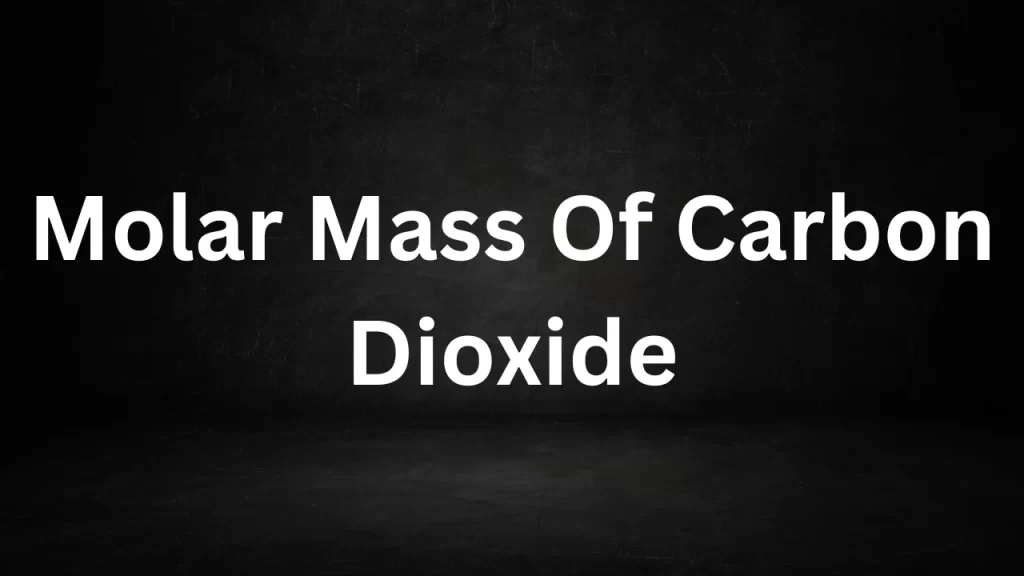Tag: Molar Mass Of Carbon Dioxide
Molar Mass Of Carbon Dioxide
Molar Mass Of Carbon Dioxide: The molar mass of carbon dioxide (CO2) is a fundamental concept in chemistry that plays a pivotal role in understanding chemical reactions, stoichiometry, and the behavior of gases.
This value is not only essential for academic purposes but also finds practical applications in various fields, including chemistry, environmental science, and industry. In this article, we will delve into the molar mass of carbon dioxide, its calculation, significance, and practical applications.

Molar Mass Of Carbon Dioxide
Defining Molar Mass
Molar mass denotes the weight of one mole of a specific substance, usually expressed in grams per mole (g/mol). In the case of carbon dioxide (CO2), the mol mass represents the combined mass of one mole of carbon (C) atoms and two moles of oxygen (O) atoms.
The Calculation
To determine the mol mass of carbon dioxide, we need to sum the atomic masses of its constituent elements, carbon (C) and oxygen (O), using their respective atomic masses found on the periodic table. The molar mass of carbon is approximately 12.01 g/mol, while the molar mass of oxygen is approximately 16.00 g/mol.
Using these values, we can calculate the molar mass of CO2 as follows:
Molar Mass of CO2 = (Molar Mass of C) + 2 × (Molar Mass of O) Molar Mass of CO2 = (12.01 g/mol) + 2 × (16.00 g/mol) Molar Mass of CO2 ≈ 44.01 g/mol
So, the mol mass of carbon dioxide (CO2) is approximately 44.01 grams per mole.
Significance in Chemistry
- Stoichiometry: The mol mass of carbon dioxide is crucial in stoichiometry, which involves calculating the quantities of reactants and products in chemical reactions. It helps chemists determine the amount of CO2 produced or consumed in a reaction.
- Gas Laws: In the study of gases, the molar mass of CO2 is used in various gas laws, such as the Ideal Gas Law, to relate the mass, volume, pressure, and temperature of gases.
- Combustion Reactions: Understanding the mol mass of CO2 is essential in combustion reactions, as it helps in calculating the amount of carbon dioxide produced when a substance burns.
Real-World Applications
- Environmental Science: Knowledge of the mol mass of CO2 is vital for measuring and monitoring greenhouse gas emissions, particularly in the context of climate change research.
- Industrial Processes: Industries utilize the molar mass of CO2 in processes such as carbon capture and storage (CCS), where CO2 is captured to reduce emissions.
- Food and Beverage Industry: The mol mass of CO2 is relevant in carbonation processes, as it helps in determining the amount of carbon dioxide needed to create carbonated beverages.
Conclusion
The mol mass of carbon dioxide (CO2), approximately 44.01 g/mol, s a fundamental concept in chemistry with wide-ranging implications. It serves as a key component in stoichiometry, gas laws, and combustion reactions, contributing to our understanding of chemical processes. Furthermore, its significance extends to real-world applications in environmental science, industry, and even everyday consumables. Understanding the molar mass of CO2 is not only a core concept in chemistry but also a crucial aspect of addressing contemporary environmental challenges.
Read More
- Difference Between Force And Momentum
- Law Of Conservation Of Linear Momentum
- Molecular Weight Of MgSO4
- Molecular Weight Of H3PO4
- Molecular Mass Of CaCl2
Frequently Asked Questions (FAQs) On Molar Mass Of Carbon Dioxide
1. What is the molar mass of carbon dioxide (CO2)?
The mol mass of carbon dioxide (CO2) is approximately 44.01 grams per mole (g/mol).
2. How is the molar mass of carbon dioxide calculated?
The molar mass of CO2 is determined by summing the molar masses of carbon (C) and two oxygen (O) atoms due to the molecule’s composition. The molar mass of C is approximately 12.01 g/mol, and the mol mass of O is approximately 16.00 g/mol.
3. Why is knowing the molar mass of carbon dioxide important?
Understanding the mol mass of CO2 is essential in chemistry for stoichiometry, gas laws, and combustion reactions. It also has real-world applications in environmental science, industry, and food and beverage production.
4. What is stoichiometry, and how is the molar mass of carbon dioxide used in it?
Stoichiometry is the study of the quantitative relationships between reactants and products in chemical reactions. In stoichiometry, the molar mass of CO2 calculates the CO2 amount in chemical reactions.
5. How is the molar mass of carbon dioxide relevant to the study of gases?
CO2’s molar mass is vital in gas laws, linking mass, volume, pressure, and temperature.